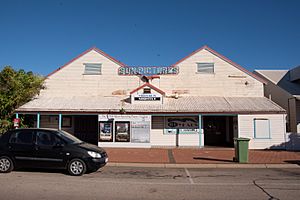Sun Picture Gardens facts for kids
Quick facts for kids Sun Picture Gardens |
|
|---|---|

The facade of the building in 2018
|
|
| Location | 8 Carnarvon Street Broome WA 6725 |
| Built | 1916 |
| Type | State Registered Place |
| Designated | 9 Feb 1996 |
| Reference no. | 293 |
| Lua error in Module:Location_map at line 420: attempt to index field 'wikibase' (a nil value). | |
The Sun Picture Gardens, also known as Sun Pictures, is the oldest outdoor movie theater still open in the world. It is located in Broome, Western Australia. Unlike most outdoor cinemas, it shows many films every night. Most other outdoor cinemas only show one or two movies a week.
Contents
A Look Back: History of Sun Pictures
Starting as a Store
After the town of Broome was built, many people from Asia moved there. This led to a special area called Chinatown. In 1903, the Yamsaki family opened a store on Carnarvon Street. They sold Asian clothes, food, and other goods. The family loved theater, so they made part of their building into a Noh theater. Later, in 1913, a master pearler named Ted Hunter bought the building. He started turning the store into a movie theater.
The Silent Movie Era
Sun Pictures first opened its doors on December 9, 1916. It was completely full! The very first movie shown was a racing story called Kissing Cup. During this time, a local person known as "Fairy" became famous. She was known for playing the piano during the silent films. Her most popular song was "If You Were the Only Girl (In the World)". In 1924, W.H. Milner and Leonard R. Knight bought Sun Pictures. Their wives helped by working at the ticket office and talking to the public.
Movies Get Sound and World War Two Times
In 1933, the cinema was changed so it could play movies with sound. The first "talkie" film shown was Monte Carlo. Mr. Milner passed away in 1940. Mr. Knight then went back to Perth. Mrs. Milner kept running the cinema by herself. But in 1942, Broome had to be emptied out. This happened just two days before a Japanese air raid.
During this time, the movie equipment was damaged. Army officers fixed it and used the cinema for themselves. But they had trouble changing the movie reels. Sometimes it took them up to forty minutes! While they were changing reels, a song called You Look Like a Monkey When you Grow Old played over and over.
When the Ocean Came Inside
For many years, the cinema would flood almost every night. This was because of the tides. Some people even joked that you could catch a fish during a movie! Most nights, people would leave the cinema to find the street outside covered in water. Men would often carry women to higher ground, no matter who they were.
Changes for Everyone
Before 1967, people were seated in different parts of the cinema based on their background. Some people sat in the middle, while others sat on the left or right. People on the right side had to use a separate door and sit on hard wooden benches.
This unfair seating changed when new laws were made in 1967. These laws said that everyone should be treated equally. After this, everyone could sit wherever they wanted.
Stopping the Floods and Making it New Again
In 1974, a special wall was built to stop the tidal flooding. This made going to the cinema much more enjoyable! In 1989, Sun Pictures was added to the Register of the National Estate. This meant it could only be fixed up, not changed or torn down. In 1995, it was also added to the State Register of Heritage Places. This was because it was very important to the area's culture and history.
Marrissa Ferraz bought the cinema in 1997. She started fixing it up in 1999. In 2002, an indoor cinema called Sun Cinemas opened. It worked alongside the old Sun Pictures. In 2004, the cinema made it into Guinness World Records. It was named the "Oldest Open Air Cinema in Operation."
A Special Movie Premiere
In 2009, Sun Pictures hosted the first showing of a musical film called Bran Nue Dae. This movie was made in Western Australia. The stars walked on a red dirt carpet, and Ernie Dingo sang the movie's main song.


